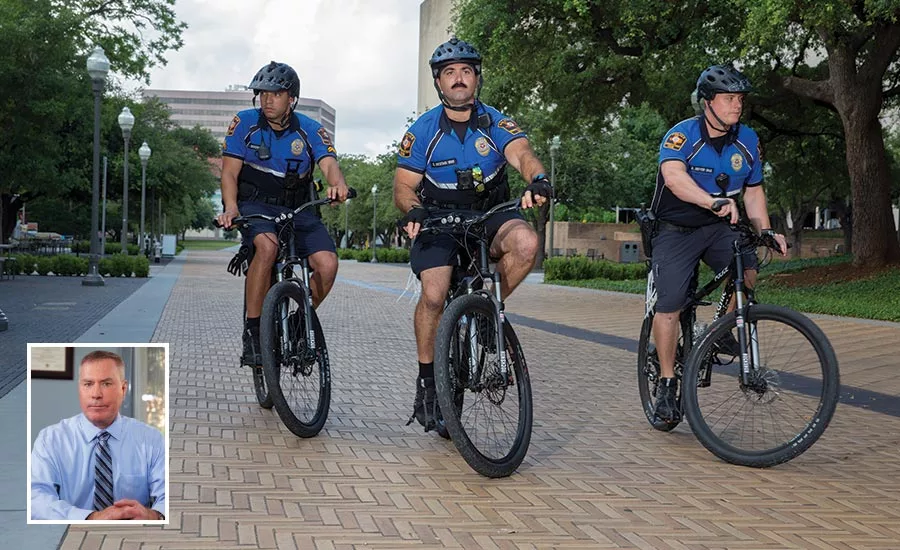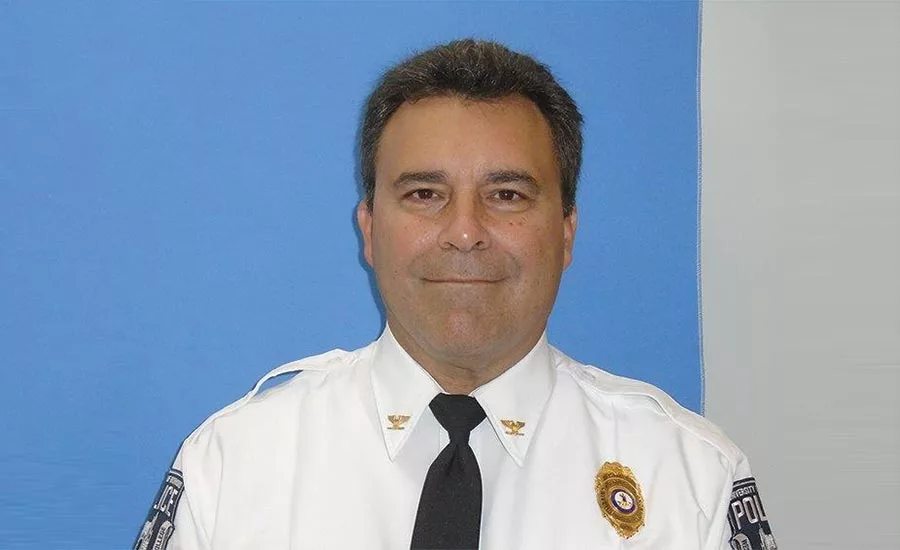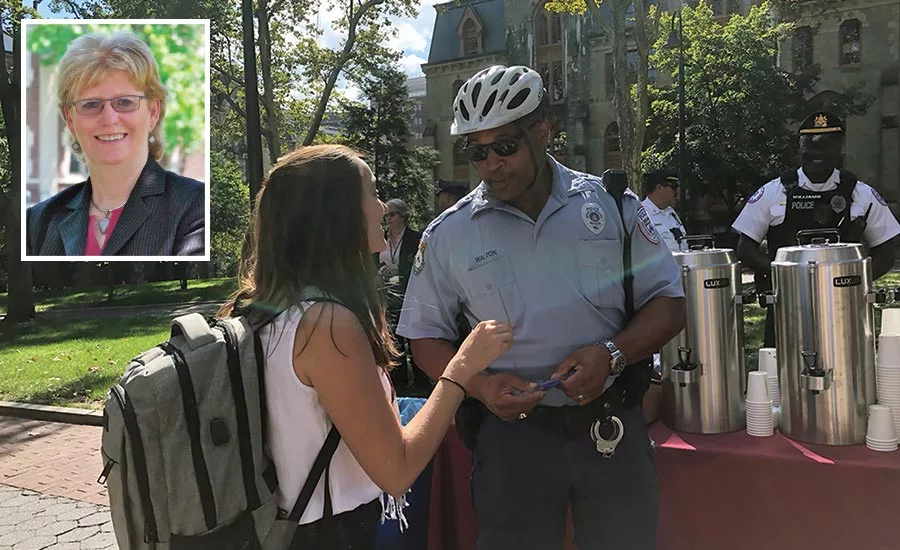It Takes a Village: Continuous Communication for Higher Education
Educating a new class of freshmen about personal safety on campus requires a team effort and, often, an unconventional approach.

“We’re encouraging police to remain out of their cars as much as possible,” says UT-Austin Chief of Police David Carter, who adds that students are more likely to interact with officers on foot or on bicycle patrols than those in patrol cars.
Photos courtesy of The University of Texas at Austin

At the University of Richmond, Associate Vice President of Public Safety and Chief of Police Dave McCoy is continuously striving to present personal safety and preparedness to students in new and engaging ways, including a disaster preparedness dinner event.
Photo courtesy of Dave McCoy

University of Pennsylvania police and students came together October 3, 2018, for a “Coffee with a Cop” event on campus, part of a national effort to bring police officers together with the communities they serve to learn more about each other. Penn Public Safety uses events like these as an opportunity to “make an emotional deposit in the bank,” says Penn VP of Public Safety and Chief of Police Maureen Rush.
Photo courtesy of Stacy Ritchey, Division of Public Safety
Every autumn, a new wave of young students floods onto college campuses, eager and excited for the next phase of their lives and ready to explore their newfound freedom. They are not always eager, however, to consider safety and security a top priority. This poses a continuous challenge for university security leaders not just during freshman orientation, but year-round: how do you educate 17- and 18-year-old students about practical personal safety?
At the University of Pennsylvania, located in urban Philadelphia, student safety messaging is grouped into four main themes: safety and security, alcohol use, sexual assault and mental health. According to Maureen Rush, Vice President for Public Safety and Superintendent of Police for Penn, it’s essential to teach students how to have fun safely, which includes learning street smarts, utilizing security escort programs, understanding the medical amnesty policy around alcohol use, knowing which resources are available for students in need, and how to be a good bystander – or as Rush puts it, “a good Penn citizen.”
Rush utilizes a team approach to getting security messaging out to the Penn student population, starting with a 90-minute presentation during new student orientation, primarily put on by other Penn students. College house (dormitory) liaison programs assign two detectives to each house, and they will attend house events like baseball games or dinners throughout the year to build a more personal connection. Sexual assault resources and messaging is disseminated alongside similar messaging from Student Health, and Public Safety works with the newly created Chief Wellness Officer at Penn to craft mental health messaging.
At Penn, students can help each other by utilizing the Penn Guardian app, developed on the Rave Guardian platform, to send a tip to Public Safety. This enables students to “see something, say something” anonymously. For example, Rush says, a student at a house party who witnesses unsafe behavior or a dangerously intoxicated student could send in a tip, and through the app’s GPS locator function, Public Safety will respond and take care of the situation without drawing attention to the caller.
At the University of Texas at Austin, “communication never stops,” says Chief David Carter, Assistant Vice President for Campus Security and UT-Austin Chief of Police.
Through a revamped district representative program – part of a larger community policing initiative – Campus Police and Security officers are assigned to one of eight patrol districts, where they focus on getting out and about with the student community. “We’re encouraging police to remain out of their cars as much as possible. We’re encouraging them to walk their beats, especially on campus, as students are more willing to interact with an officer on foot or on a bicycle than one in their patrol car,” Carter says.
The officers are available for educational opportunities within their districts as well. For example, if a sorority house wants to arrange for a presentation on how to be safe on campus at night, they can contact their district representative. If an RA in a dorm notes an uptick in bicycle thefts, they can request a meeting or presentation on how to mitigate theft risks.
Beyond policing efforts, UT-Austin Campus Security seeks to engage with students during freshmen orientation and parent sessions, as well as throughout the year via social media, articles in student newspapers and in-person presentations and programs.
“It’s a complex network of communication,” says Carter. “We partner as much as possible to get our message out, including with Parking & Transportation, the Dean of Students and outside partners like the City of Austin and some non-profits.”
At the University of Richmond in Virginia, Associate Vice President of Public Safety and Chief of Police Dave McCoy is working with an unlikely partner to get the word out about disaster preparedness: Dining Services.
“We’re continuously trying to get the word out about personal preparedness, from an all-hazards approach,” McCoy says. “Everyone needs to have a plan if something goes south. The Disaster Preparedness Dinner was another step to this. The dining hall is one of the top congregating areas for students, so we partnered with Dining Services on a unique menu and unique educational event.”
The dining hall was lit with lanterns to emphasize the importance of having flashlights during extreme weather, and the menu featured food that could be prepared when the power is out. Staff showed students what supplies were needed in emergency kits and answered questions about emergency procedures and best practices – both on campus and off.
The timing of the meal was particularly apt – Hurricane Florence had hit the East Coast just a few days before, and two days before the dinner, tornadoes hit the area, causing students to shelter in place for hours. The dinner proved to be a good forum for students to ask Public Safety staff questions about the incident, what campus generators do and don’t power, and what students’ responsibilities are during a disaster.
“The best way to communicate about these issues is through direct conversation,” McCoy says. “It’s often difficult to broach the topic of personal safety with 17-21-year-olds… so the ability to have university officials on-hand during events to answer questions is invaluable.”
In light of the preceding events, Public Safety cancelled the “disaster movie” portion of the evening, replacing it with a Red Cross donation drive for those affected by the hurricane and tornadoes. McCoy also tied the evening in with an opt-in station for emergency alerts and kicked off a scavenger hunt across campus to build a preparedness kit.
Looking for a reprint of this article?
From high-res PDFs to custom plaques, order your copy today!





